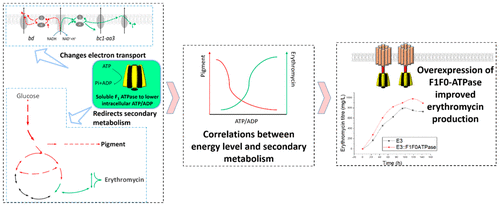当前位置:
X-MOL 学术
›
ACS Synth. Biol.
›
论文详情
Our official English website, www.x-mol.net, welcomes your
feedback! (Note: you will need to create a separate account there.)
Cofactor Engineering Redirects Secondary Metabolism and Enhances Erythromycin Production in Saccharopolyspora erythraea.
ACS Synthetic Biology ( IF 3.7 ) Pub Date : 2020-02-28 , DOI: 10.1021/acssynbio.9b00528 Xiaobo Li 1, 2 , Jun Chen 2 , Joakim M Andersen 2 , Ju Chu 1 , Peter R Jensen 2
ACS Synthetic Biology ( IF 3.7 ) Pub Date : 2020-02-28 , DOI: 10.1021/acssynbio.9b00528 Xiaobo Li 1, 2 , Jun Chen 2 , Joakim M Andersen 2 , Ju Chu 1 , Peter R Jensen 2
Affiliation

|
Saccharopolyspora erythraea is used for industrial erythromycin production. To explore the physiological role of intracellular energy state in metabolic regulation by S. erythraea, we initially overexpressed the F1 part of the endogenous F1F0-ATPase in the high yielding erythromycin producing strain E3. The F1-ATPase expression resulted in lower [ATP]/[ADP] ratios, which was accompanied by a strong increase in the production of a reddish pigment and a decreased erythromycin production. Subsequent transcriptional analysis revealed that the lower intracellular [ATP]/[ADP] ratios exerted a pleotropic regulation on the metabolism of S. erythraea. The lower [ATP]/[ADP] ratios induced physiological changes to restore the energy balance, mainly via pathways that tend to produce ATP or regenerate NADH. The F1-ATPase overexpression strain exhibited a state of redox stress, which was correlated to an alteration of electron transport at the branch of the terminal oxidases, and S. erythraea channeled the enhanced glycolytic flux toward a reddish pigment in order to reduce NADH formation. The production of erythromycin was decreased, which is in accordance with the net ATP requirement and the excess NADH formed through this pathway. Partial growth inhibition by apramycin increased the intracellular [ATP]/[ADP] ratios and demonstrated a positive correlation between [ATP]/[ADP] ratios and erythromycin synthesis. Finally, overexpression of the entire F1F0-ATPase complex resulted in 28% enhanced erythromycin production and markedly reduced pigment synthesis in E3. The work illustrates a feasible strategy to optimize the distribution of fluxes in secondary metabolism.
中文翻译:

辅助因子工程技术可重定向次要代谢并提高红糖酵母中红霉素的产生。
糖多孢菌(Saccharopolyspora erythraea)用于工业红霉素生产。为了探索红细胞链球菌在代谢调节中细胞内能量状态的生理作用,我们首先在高产红霉素菌株E3中过表达了内源性F1F0-ATPase的F1部分。F1-ATPase的表达导致较低的[ATP] / [ADP]比,这伴随着红色颜料产量的大幅增加和红霉素产量的下降。随后的转录分析表明较低的细胞内[ATP] / [ADP]比率对红霉菌的代谢具有多效性调节。较低的[ATP] / [ADP]比引起生理变化,以恢复能量平衡,主要是通过倾向于产生ATP或再生NADH的途径进行的。F1-ATPase过表达菌株表现出氧化还原状态,这与末端氧化酶分支上的电子传递的变化相关,并且红球菌将增强的糖酵解通量引导至带红色的色素,以减少NADH的形成。红霉素的产量减少了,这与ATP的净需求和通过该途径形成的过量NADH相一致。阿普霉素对部分生长的抑制作用增加了细胞内[ATP] / [ADP]的比率,并证明[ATP] / [ADP]的比率与红霉素合成呈正相关。最后,整个F1F0-ATPase复合物的过表达导致E3中红霉素生成增加28%,色素合成明显减少。
更新日期:2020-02-28
中文翻译:

辅助因子工程技术可重定向次要代谢并提高红糖酵母中红霉素的产生。
糖多孢菌(Saccharopolyspora erythraea)用于工业红霉素生产。为了探索红细胞链球菌在代谢调节中细胞内能量状态的生理作用,我们首先在高产红霉素菌株E3中过表达了内源性F1F0-ATPase的F1部分。F1-ATPase的表达导致较低的[ATP] / [ADP]比,这伴随着红色颜料产量的大幅增加和红霉素产量的下降。随后的转录分析表明较低的细胞内[ATP] / [ADP]比率对红霉菌的代谢具有多效性调节。较低的[ATP] / [ADP]比引起生理变化,以恢复能量平衡,主要是通过倾向于产生ATP或再生NADH的途径进行的。F1-ATPase过表达菌株表现出氧化还原状态,这与末端氧化酶分支上的电子传递的变化相关,并且红球菌将增强的糖酵解通量引导至带红色的色素,以减少NADH的形成。红霉素的产量减少了,这与ATP的净需求和通过该途径形成的过量NADH相一致。阿普霉素对部分生长的抑制作用增加了细胞内[ATP] / [ADP]的比率,并证明[ATP] / [ADP]的比率与红霉素合成呈正相关。最后,整个F1F0-ATPase复合物的过表达导致E3中红霉素生成增加28%,色素合成明显减少。











































 京公网安备 11010802027423号
京公网安备 11010802027423号